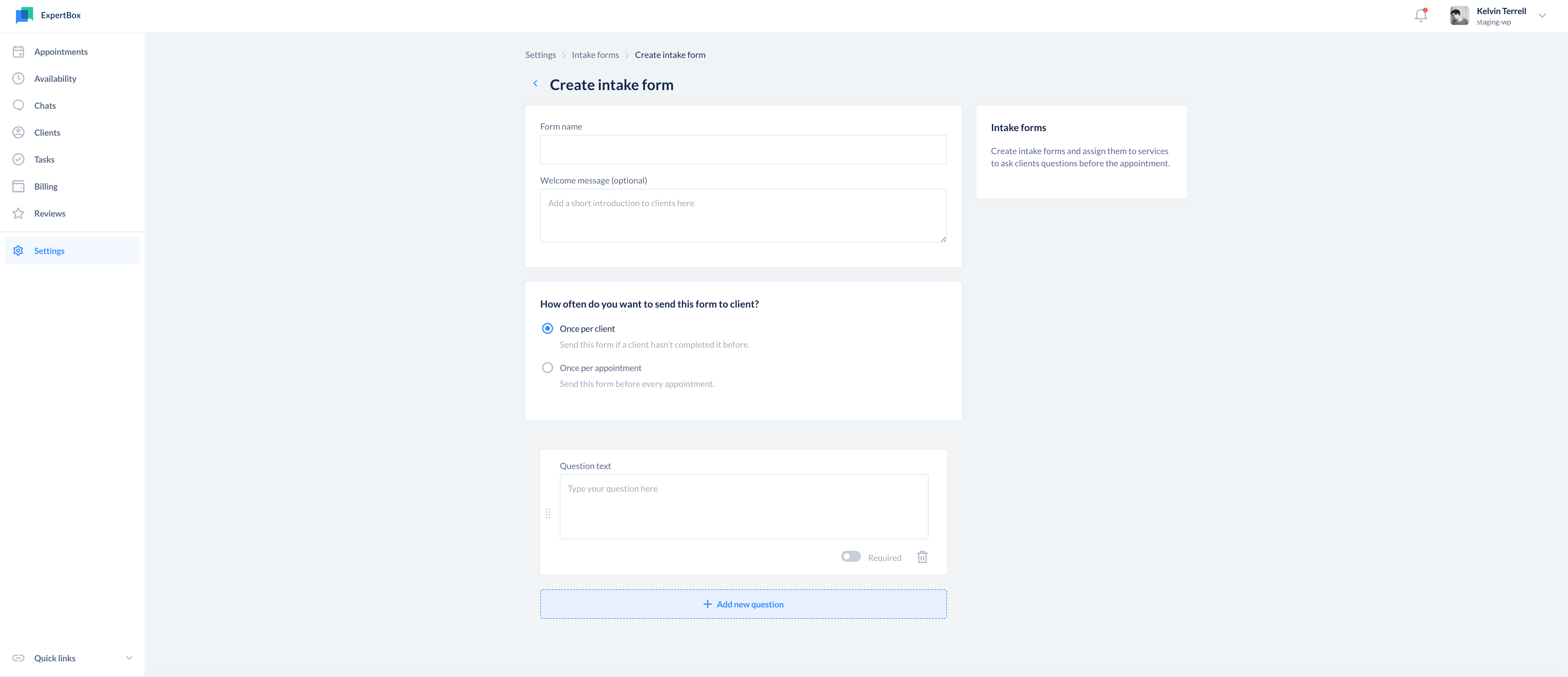If you’re beginning your coaching practice and have just a few clients, finding data about a specific client might not be a problem. However, when your client base is growing rapidly, it becomes harder to keep everything in your head, and you must be able to retrieve relevant client information quickly when necessary.
Intake forms are a game-changer when it comes to maintaining an effective client database, enhancing productivity, providing high-quality coaching sessions, and offering the best client experience.
In this guide, we provide a comprehensive view of life coaching intake forms and tell you how to create your own unique intake form.
What is a life coaching intake form?
An intake form is a document that collects information you need to capture about a client in order to work with the client and deliver your services.

An intake form includes questions that help you and your client ensure that you’re the right fit for each other and help you determine whether your coaching program can address the client’s needs and concerns.
With the right tools, you can create and customize a life coaching intake form and send it to a new client when they book their first session. New clients can fill out the form at their convenience, giving you all the information you need before your first coaching session.
Life coaching intake forms may ask for information such as:
- Contact details — address, phone number, marital status, profession, etc.
- Personality-related matters — desires, goals, strengths, faults, motivators, current lifestyle, challenges, values, past experiences, and much more
This is what an intake form looks like in ExpertBox:

Why do you need a life coaching intake form?
A discovery call (a one-on-one call with prospective clients to determine whether your services match them) is a great starting point, but you can’t learn everything you need to know about a client while introducing yourself. You need to allocate time for follow-up questions to develop an individualized coaching plan to better serve the client.
With an intake form, you can get the information you need up front, keep it in one place, and jump on your discovery call with an understanding of your client’s situation.
An intake form helps you determine (before your first session) what the client expects to achieve from their coaching experience and what obstacles they may encounter. This will not only save you time but will show you whether a potential client’s needs and interests align with your coaching services.
What are the benefits of an intake form for life coaching?
Let’s see how coaching intake forms can help you grow your business and bring in more loyal clients.
- Know the client’s expectations. By getting accurate client information up front, you become conscious of your client’s needs and wants, increase the chances of providing the right solution, and minimize the risk of not addressing significant client issues during your initial session. You no longer need to make assumptions about the client’s pain points and desires.
- Save time and resources. Thanks to digital intake forms, you can ensure smoother client onboarding without phone calls, emailing, and cumbersome paperwork.
- Easily recognize those who can benefit from your coaching services. During the intake process, you can see who is a perfect fit for your practice and who is not. If a potential client is not a good fit, you can refer them to a colleague if they would be better served by another type of coaching. This will help you grow your business while having clients you enjoy working with.
- Simplify the client onboarding process. You can use intake forms to let your clients easily enroll in your coaching program, saving your clients’ time and effort as well as your own while collecting the information you need to start an effective coaching program.
- Earn clients’ trust. When you get client information before your first conversation, you can jump into the first call fully prepared and knowing with whom you will talk. This is fundamental for building strong client relationships.
Types of life coaching intake forms
To ensure a client is a match for your coaching services and coaching style, consider splitting your intake process into two parts, each with its own intake form. In the first part of the intake process, you could use a general form to define whether coaching is right for the client. In this form, you can include questions like these:
- Do you want to bring something new into your life?
- Are you eager to try new approaches to make a shift?
- Are you ready to change your way of thinking to achieve what you want?
- Have you ever tried some type of therapy, coaching, or counseling that helped you address difficulties or achieve your personal or professional goals?
- Do you have doubts about your methods to reach your goals?
- Is it okay for you to feel uncertain at times?
Note that these questions can be answered with a yes or no.
Tip: Take a look at this template to get a better grasp on what to include.
Then if you ensure that your coaching can help the client fulfill their goals, you can determine the client’s real interests and needs and explore the client’s challenges, background, reasons for working with a coach, past experiences, etc. You can explore:
- what the client expects to achieve from coaching
- what the client’s real intentions are
- what coaching model and style will best suit the client
Tip: This template is an example that you can use as inspiration for your life coaching intake form.
What should you include on a life coaching intake form?
Here are questions to put on the intake form to help you get started. We’ll split our questions into four steps.
Step 1. Collect contact information
You should begin with basic information. Collect client contact information such as name, address, phone number, and email.
You may also add questions to find out the client’s hobbies and interests, what they enjoy doing the most, what activities they dislike, etc.
Step 2. Determinate the client’s goals
Knowing your client’s goals and what the client is striving towards assists you in defining the scope of your coaching program and helps you create a coaching strategy. Consider these questions:
- What are your goals for your personal life over the next couple of years?
- Where do you envision yourself in X years?
- What are some of your core values?
- What are your objectives for the next five months?
Step 3. Work through the client’s concerns
Find out what keeps the client from achieving their goals and living the life they want. These questions will help you figure that out:
- What or who do you think stops you from achieving your goals?
- What problems are you facing?
- What would happen in your life if you overcame these problems?
Step 4. Get to know the client better
Knowing your client’s dreams, desires, and goals is just as essential as exploring their past experiences. Taken as a whole, this information can allow you to better understand what has brought the client into their current state. Ask questions such as:
- What are your most significant achievements and struggles?
- Are you satisfied with the current quality of your life?
- What personal traits may hinder you from achieving success?
- What do you appreciate about yourself that has helped you achieve your goals?
Step 5. Decide on a suitable coaching approach
Prior to providing effective coaching, you should learn about your client’s individual communication preferences. This means asking the client how they prefer to interact with you, such as through video conferencing, private face-to-face sessions, phone calls, etc.
You can also use additional communication channels between your coaching sessions such as social media, email, and messengers.
In order to select the most appropriate coaching model, you should also find out:
- how the client responds to both criticism and compliments
- how often the client is ready to evaluate their progress and the effectiveness of the coaching program
- what motivates the client while learning and working
- how many coaching sessions the client is interested in having
- and so on
The choice of coaching model can significantly impact a coach’s effectiveness. This guide lists some practical coaching models and shows how the right approach to coaching can help you develop your unique coaching style and deliver the best possible results for your clients.
Step 6. Leave space for what might have been missed
Ask if there is anything else the client wants to add.
Software to create intake forms
To satisfy your clients with a fast, high-quality, and flexible intake process, we recommend opting for software that can remove the burden of paper forms and help you digitize your intake process.
Instead of wasting time manually crafting different types of intake forms, you can do this automatically in ExpertBox in a few easy steps:
- Create a custom intake form and add your own questions.
- Assign a relevant intake form to each service and let your clients provide you with all relevant information when booking a session.
- Automatically gather your clients’ answers in your CRM.
This guide explains in detail why coaching software is a must for your online coaching business and what coaching software currently leads the market.
Are you looking for more practical tips on developing and running a profitable life coaching business? If so, subscribe to our newsletter and get the insider information you need to succeed!
FAQ
-
An intake form is a document that collects information you need to capture about a client in order to work with the client and deliver your services.
-
A discovery call (a one-on-one call with prospective clients to determine whether your services match them) is a great starting point, but you can’t learn everything you need to know about a client while introducing yourself. You need to allocate time for follow-up questions to develop an individualized coaching plan to better serve the client.
-
Let’s see how coaching intake forms can help you grow your business and bring in more loyal clients.
- Know the client’s expectations
- Save time and resources
- Easily recognize those who can benefit from your coaching services
- Simplify the client onboarding process
- Earn clients’ trust
-
Here are questions to put on the intake form to help you get started. We’ll split our questions into four steps.
1. Collect contact information
2. Determinate the client’s goals
3. Work through the client’s concerns
4. Get to know the client better
5. Decide on a suitable coaching approach
6. Leave space for what might have been missed




